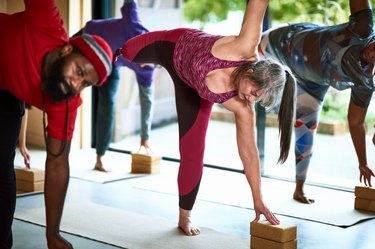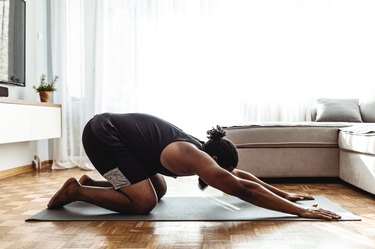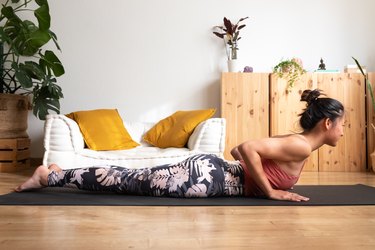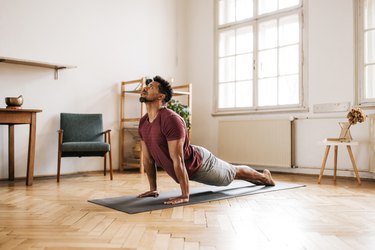
Half moon pose (Ardha Chandrasana) enables you to tap into a feeling of both strength and weightlessness. This popular yoga posture requires steadiness and stability as you balance on one leg with all four limbs radiating out from the center of your body.
However, it can be easily modified for better accessibility. Read on to learn more about half moon pose, how to practice it, the benefits it offers and variations to make it easier or harder.
Video of the Day
- What is half moon pose? Half moon can be translated from the Sanskirt name "Ardha Chandrasana" ("Ardha" meaning "half," "Chandra" meaning "shining" or "moon" and "Asana" meaning "pose"). It's classified as a standing balancing posture and often follows triangle pose in a yoga flow because there's a natural transition and similar shape between the two postures.
- Who can do half moon pose? Because half moon is a single-leg standing balancing pose, maintaining balance is key. Using props and modifications makes the pose accessible for most people, but those who have difficulty balancing or a high risk of falling should be cautious. Anyone with low back pain and spinal conditions, such as disc herniation, should avoid this posture altogether. It's also not recommended for people who are six months pregnant or more.
- What muscles does half moon pose work? Half moon pose targets the quadriceps, glutes, hamstrings, ankle and foot muscles of your standing leg, according to Lindsay Kocka, registered yoga teacher and functional movement and mobility trainer. It also activates your deep core muscles — specifically, the psoas muscle (which sits toward the back of your spine), as it works to stabilize your body in the pose while your back leg is lifted.
- Is half moon pose a beginner or an advanced pose? Half moon can challenge even the most advanced practitioners because of the intense focus a balancing pose requires — even a slight distraction can knock you off your center. It's also critical to have enough strength in your legs and flexibility in your hips to stay balanced. However, with the use of props and modifications, it's a fantastic way to build more strength in your lower body even if you're just starting out.
- How long should you hold half moon pose for? Half moon pose can be held for three to five cycles of breath, or about 20 to 30 seconds. But you can also include the transitional time it takes to get in and out of the pose as a part of the total time spent in half moon pose. This can help you gain an appreciation for the entire process of doing a yoga pose, rather than solely focusing on achieving the "final" shape.
How to Do Half Moon Pose With Proper Form
It's common to want to focus more on using your arms and legs in half moon pose instead of initiating the movement from your core. But one of the main functions of the deep core muscles is to provide stability and support your spine as you move, which can be felt in half moon.
As you shift your center of gravity to balance on one leg, move slowly and mindfully to tap into the strength and flexibility of your core. That soaring feeling through your arms and legs comes as a result of staying centered and grounded.
- Begin standing in the center of your yoga mat and step your feet about 4 feet apart from each other. Place your hands on your hips.
- Point your right foot to the long edge and point your left foot toward the top of the mat.
- Bend sideways to your left, tipping your pelvis to the side to initiate the movement from your hips first. Then allow the rest of your torso to follow.
- Bend your left knee and place your left hand down on the floor about a foot in front of you.
- Keep your right hand on your hip, and keep a slight bend in your left knee so you don’t hyperextend it as you inhale to lift your right (back) leg in line with your hips.
- Exhale as you turn your chest open to the side and draw your navel into your spine to engage your core.
- Inhale and elongate your spine, reaching all the way through the crown of your head. If you feel steady, reach your right arm up toward the sky.
- Exhale as you press down into your standing leg and kick your top leg up against gravity to remain active in the pose.
- Remain here for 3 to 5 rounds of breath.
- When you’re ready to exit the pose, gently bend your front knee and lower your top leg down.
- Repeat on the other side.
Benefits of Half Moon Pose
In addition to building heat and strength in your legs and activating your core, half moon pose also helps to stretch your hips, low back, chest and arms. Practicing a balancing pose also demands a high degree of focus and a willingness to explore the unknown.
"I always appreciate a pose that upholds a degree of playfulness," Kocka says. "Moving into half moon frequently feels like an invigorating leap of faith that shows up very differently in my body from day to day."
Half Moon Pose Common Mistakes (and How to Fix Them)
1. Your Standing Leg Turns Inward
Due to our largely sedentary nature, it's common to have tight and weak hip muscles. If this is true for you, the foot on your standing leg will tend to turn inward in half moon pose. Although it's your body's reaction to instability, it's actually a much less stable position for your foot and can knock you off balance.
Fix It
Point your toes forward or even slightly out to create a steady foundation.
2. Your Top Leg Swings Behind You
If you have a very flexible spine and not enough core strength, your top leg will tend to swing back behind you, which is less stable.
Fix It
Work on bringing your top leg slightly forward. This may take some time, and doing ab exercises for better stability can help. Add core moves like planks, side planks and glute bridges to your workout routine, according to the National Academy of Sports Medicine (NASM).
3. You Have Trouble Lifting Your Top Leg and Opening Your Chest
If you have less flexibility and tension in your hips and shoulders, you may struggle to lift your top leg and open your chest in the pose.
Fix It
Create more space by placing a block beneath your bottom hand and resting your top hand on your hip to focus more on elongating your spine and rotating your chest open.
Half Moon Pose Modifications
1. Half Moon Pose With Yoga Block
- Begin standing in the center of your yoga mat and step your feet about 4 feet apart from each other. Place your hands on your hips.
- Place a yoga block vertically at the top left corner of the mat.
- Point your right foot to the long edge and point your left foot toward the top of the mat.
- Bend sideways to your left, tipping your pelvis to the side to initiate the movement from your hips first. Then allow the rest of your torso to follow.
- Bend your left knee and place your left hand down on the yoga block, moving it about a foot in front of you or directly under your shoulder.
- Keep your right hand on your hip, and keep a slight bend in your left knee so you don’t hyperextend it as you inhale to lift your right (back) leg in line with your hips.
- Exhale as you press down into the block, turn your chest open and firm your navel to your spine to engage your core.
- Inhale and elongate your spine, reaching all the way through the crown of your head. If you feel steady, reach your right arm up toward the sky.
- Exhale as you press down into your standing leg and kick your top leg up against gravity to remain active in the pose.
- Remain here for 3 to 5 rounds of breath.
- When you’re ready to exit the pose, gently bend your front knee and lower your top leg down.
- Repeat on the other side.
2. Half Moon Pose at Wall
- Begin standing against a wall in the center of your yoga mat and step your feet about 4 feet apart from each other. Place your hands on your hips.
- Place a yoga block vertically at the top left corner of the mat.
- Point your right foot to the long edge and point your left foot toward the top of the mat.
- Bend sideways to your left, tipping your pelvis to the side to initiate the movement from your hips first. Then allow the rest of your torso to follow.
- Bend your left knee and place your left hand down on the yoga block, moving it about a foot in front of you or directly under your shoulder.
- Keep your right hand on your hip, and keep a slight bend in your left knee so you don’t hyperextend it as you inhale to lift your right (back) leg in line with your hips and lean back into the wall for support.
- Exhale as you press down into the block, turn your chest open and firm your navel to the spine to engage your core.
- Inhale and elongate your spine, reaching all the way through the crown of your head, allowing the back of your head to make contact with the wall. If you feel steady, reach your right arm up toward the sky.
- Exhale as you press down into your standing leg and kick your top leg up against gravity to remain active in the pose.
- Remain here for 3 to 5 rounds of breath.
- When you’re ready to exit the pose, gently bend your front knee and lower your top leg down.
- Repeat on the other side.
Half Moon Pose Progressions
1. Sugar Cane Pose (Ardha Chandra Chapasana)
- Begin standing in the center of your yoga mat and step your feet about 4 feet apart from each other. Place your hands on your hips.
- Point your right foot to the long edge and point your left foot toward the top of the mat.
- Bend sideways to your left, tipping your pelvis to the side to initiate the movement from your hips first. Then allow the rest of your torso to follow.
- Bend your left knee and place your left hand down on the floor about a foot in front of you.
- Keep your right hand on your hip, and keep a slight bend in your left knee so you don’t hyperextend it as you inhale to lift your right (back) leg in line with your hips.
- Exhale as you turn your chest open and firm your navel to your spine to engage your core.
- Inhale as you bend your top knee into your chest and grab your top foot.
- Exhale as you press down into your standing leg and kick your top leg behind you to stretch your thigh and enter into a deep backbend.
- Remain here for 3 to 5 rounds of breath.
- When you’re ready to exit the pose, gently bend your bottom knee, release your top leg and lower your top foot down.
- Repeat on the other side.
How to Add Half Moon Pose to Your Yoga Practice
You can do half moon pose in the middle of your yoga flow along with other standing postures to build heat, strength and focus.
"When sequencing a class that's leading toward Ardha Chandrasana, I'm always sure to include a myriad of postures that hold adjacent actions and alignment, like three-limbed downward facing dog, pyramid pose, standing splits, warrior II and III, active hip rotations and lunge postures with wide open arm and/or chest expansion variations," Kocka says.




